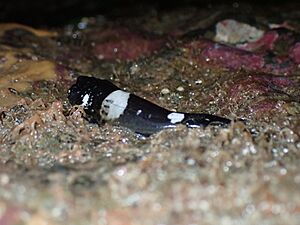Mosshead sculpin facts for kids
Quick facts for kids Mosshead sculpin |
|
|---|---|
 |
|
| Conservation status | |
| Scientific classification | |
| Synonyms | |
|
The mosshead sculpin (Clinocottus globiceps) is a cool little fish that lives in the ocean. It's part of a fish family called Cottidae, which are known as typical sculpins. You can find this sculpin in the northeastern Pacific Ocean, especially along the coasts of North America. It's also sometimes called the globe-headed sculpin because of its round head.
Contents
What's in a Name? The Mosshead Sculpin's Family Tree
Scientists give every living thing a special name, like Clinocottus globiceps for the mosshead sculpin. This helps them keep track of all the different animals! A French scientist named Charles Frédéric Girard first officially described this fish in 1858. He gave it the name Oligocottus globiceps.
The name globiceps is very fitting for this fish. It means "spherical head" or "globe-headed." This refers to the mosshead sculpin's very round head shape.
How to Spot a Mosshead Sculpin: Its Unique Look
The mosshead sculpin has some interesting features that help you identify it.
- Fins: It has two dorsal fins (on its back) with 9 or 10 stiff spines and 15 to 17 soft rays. Its anal fin (on its belly) has 10 to 12 soft rays. The caudal fin (tail fin) is rounded. Its pectoral fins (side fins) have 8 thicker rays at the bottom.
- Head: The fish has many small, fleshy growths called cirri on its head. These are especially noticeable between its eyes. It also has one blunt spine on its cheek area, near its gill cover.
- Size: The mosshead sculpin can grow up to about 19 centimeters (about 7.5 inches) long.
Where Does the Mosshead Sculpin Live? Its Ocean Home
You can find the mosshead sculpin along the western coast of North America. Its range stretches from Kodiak Island in Alaska all the way down to Gaviota, California.
This fish loves to live in the intertidal zone. This is the area of the coast that is covered by water at high tide and exposed to air at low tide. You'll often spot them in tidal pools and shallow, rocky areas where the ocean waves crash strongly. They are known to stay in one area and even show "homing behavior," meaning they can find their way back to their favorite spots.
Amazing Abilities: How the Mosshead Sculpin Survives
The mosshead sculpin has some cool tricks up its sleeve to survive in its tough environment.
- Breathing Air: This fish can actually breathe air! If the water in its tidal pool gets too warm or has too little oxygen, the sculpin can leave the water. It might hide under rocks or in seaweed.
- What It Eats: Mosshead sculpins have a varied diet. They eat small creatures like barnacles, tiny worms (like nemerteans and annelids), and small crustaceans (copepods and ostracods). They also eat algae (seaweed).
- Eating Anemones: Interestingly, they are also known to eat sea anemones, especially Anthopleura elegantissima and Epiactis prolifera. Scientists think that eating these stinging animals might be why the sculpin has developed certain body features and behaviors.


